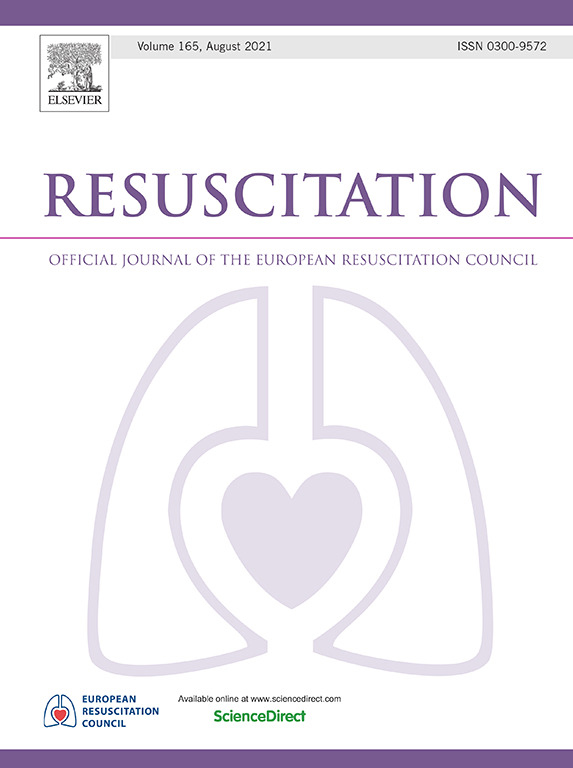超早期短潜伏期和中潜伏期SSEP可准确预测心脏骤停后的预后好坏。
IF 4.6
1区 医学
Q1 CRITICAL CARE MEDICINE
引用次数: 0
摘要
背景:心脏骤停(CA)后的准确预后对告知临床决策至关重要。目前的指南不推荐在CA后记录体感诱发电位(ssep)的特定时间点。我们评估了超早期短潜伏期和中潜伏期ssep预测神经预后好坏的能力,并将其准确性与CA后早期记录的其他预测指标进行了比较。65名昏迷成人在ca后6小时内接受了多模式预后评估,包括神经生理学(ssep和脑电图[EEG])、临床(瞳孔反射和肌阵挛)和影像学指标(脑计算机断层扫描[CT])。ca后12h采集血清神经元特异性烯醇化酶(NSE)。我们分析了ssep的N20波振幅和持续时间,以及中潜伏期N70波的存在。不良预后定义为出院时脑功能分类(CPC)为3-5。结果:双侧缺失N20波预测预后不良,特异性为100[89-100]%,敏感性为67[48-82]%。添加无N70的低振幅(10毫秒)N20波,在不影响特异性的情况下,将灵敏度提高到93[79-99]%。结论:短潜伏期和中潜伏期ssep的超早期定量评估可以高度准确地预测CA后神经预后的好坏。这种方法可以增强早期临床决策,值得在更大的队列中验证。本文章由计算机程序翻译,如有差异,请以英文原文为准。
Ultra-early short- and middle-latency SSEP accurately predict good and poor outcome after cardiac arrest
Background
Accurate prognostication following cardiac arrest (CA) is crucial for informing clinical decisions. Current guidelines do not recommend a specific time point for recording somatosensory evoked potentials (SSEPs) after CA. We evaluated the ability of ultra-early short- and middle-latency SSEPs to predict good an poor neurological outcome and compared its accuracy with that of other predictors recorded early after CA.
Methods
Prospective single-centre study. Sixty-five comatose adults underwent a multimodal prognostic assessment, including neurophysiological (SSEPs and electroencephalogram [EEG]), clinical (pupillary reflexes and myoclonus), and imaging indices (brain computed tomography [CT]) within 6 h post-CA. Serum neuron-specific enolase (NSE) was sampled 12 h post-CA. We analysed the SSEPs N20 wave amplitude and duration, and the presence of the middle-latency N70 wave. Poor outcome was defined as a Cerebral Performance Category (CPC) of 3–5 at hospital discharge.
Results
A bilaterally absent N20 wave predicted poor outcome with 100[89–100]% specificity and 67[48–82]% sensitivity. Adding low-amplitude (<1.2 µV), prolonged (>10 ms) N20 waves without N70 increased sensitivity to 93[79–99]% without compromising specificity. Conversely, a high-amplitude (>3 µV) N20 wave with normal duration with preserved N70 predicted good outcome with 94[79–99]% sensitivity and 100[89–100]% specificity. SSEPs outperformed all other early prognostic indices for both good and poor outcome prediction. All poor outcome patients had at least two concordant unfavourable predictors.
Conclusions
Ultra-early quantitative assessment of short- and middle-latency SSEPs provides highly accurate prediction of both good and poor neurological outcomes after CA. This approach may enhance early clinical decision-making and warrants validation in larger cohorts.
求助全文
通过发布文献求助,成功后即可免费获取论文全文。
去求助
来源期刊

Resuscitation
医学-急救医学
CiteScore
12.00
自引率
18.50%
发文量
556
审稿时长
21 days
期刊介绍:
Resuscitation is a monthly international and interdisciplinary medical journal. The papers published deal with the aetiology, pathophysiology and prevention of cardiac arrest, resuscitation training, clinical resuscitation, and experimental resuscitation research, although papers relating to animal studies will be published only if they are of exceptional interest and related directly to clinical cardiopulmonary resuscitation. Papers relating to trauma are published occasionally but the majority of these concern traumatic cardiac arrest.
 求助内容:
求助内容: 应助结果提醒方式:
应助结果提醒方式:


